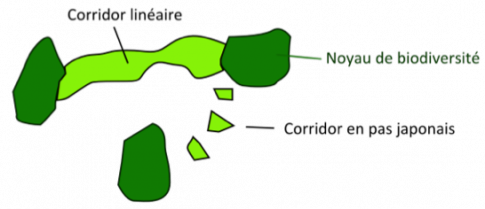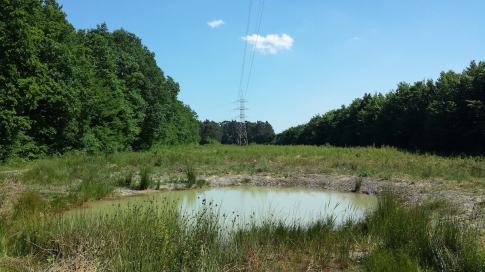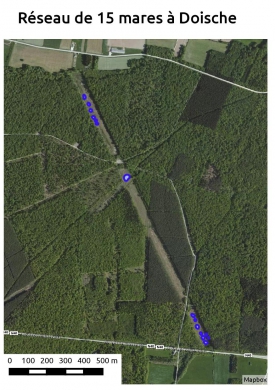News
2015-11-06
Biological inventories in ponds created by the LIFE Elia-RTE
One of the objectives of the LIFE project is to create 100 new small ponds (size 100-150 m²). Isolated or linked with other ponds (see map), these important habitats for wildlife are pretty rare in forests. They will play a major role in ecological connectivity by offering a stepping stones ("Japanese steps") connectivity for a lot of species.

Already 70 ponds in Belgium: time for inventories
The 70th ponds of the LIFE Elia-RTE project will very soon be digged ! But the first created ponds already have two years. Their colonization by vegetation and other aquatic animals (including amphibians and dragonflies) should be on good track.

Pond in Aye, South Belgium
To asses the variety of species it attracts, we conducted inventories that targets these two groups (amphibians and dragonflies) on a series of ponds spread in different spots in the Walloon Region, namely Doische, Beauraing, Marche-en-Famenne, Nassogne and Tenneville (see our sites).

Examples of ponds in Doische
Inventory of amphibians: methodology and results
Spotting and counting amphibians and newts in particular is done by using traps laid during one night in each pond. The identification and counting is done when tacking back the traps.

Setting a trap
Three of our four indegenous newts were found in the ponds. While we found several dozen of Alpine newt and Palmate newt in our 4 sites, the Smooth newt was only found in Marche-en-Famenne.

Alpine and palmated newts
The red and green frog, as well as the comman toad, were also found in the ponds. They are spotted in thewater, on pond's banks or sometimes in the traps.
Odonata inventories : species encountered
Odonata (dragonflies) begin the colonise the ponds as well. On new ponds, we spotted « common » dragonflies species that are not too specific. On the 5 sites mentioned above, inventories led in 2015 showed the presence of 17 species. For these very mobile insects, there are no standard methods for counting. In total, 2 or 3 visits are done during spring-summer, and all species are identified during these visits. Large dragonflies are identificated mostly on sight, while dameselfies are first captured in a net before a precise identification.
The top 3 species most frequently encountered are Libellula depressa, Coenagrion puella and Ischnura elegans. The most remarkable species are Cordulia aenea, Orthetrum brunneum (both encountered in Doische), Sympetrum danae et Leucorrhinia dubia. The latter, named withe-faced darter, is living exclusively on peatland areas and was spotted in the ponds between Nassogne and Tenneville (special thanks to Renee Cimino who volunterely helped us to carry out inventories on this site). A high-tension line passing through this place crosses peatlands and swamp areas restored in the framework of a former LIFE project named Saint-Hubert (2003-2007). Thanks to these news ponds of the LIFE Elia-RTE, this specie can find a network of ponds and extend its range in the Walloon Region (see map).

Leucorrhinia dubia

Distribution of Leucorrhinia dubia in Walloon Region (Source DEMNA: Fauna-Flora and Habitat Observatory).
No doubt that the future colonization of ponds by plants will lead to the discovery of new species, and we hope some surprises to come !







